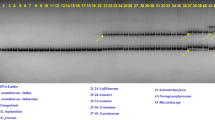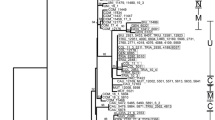Abstract
Twenty four chloroplast microsatellite loci having more than ten mononucleotide repeats were identified from the entire chloroplast DNA sequence of common wheat, Triticum aestivum cv Chinese Spring. For each microsatellite, a pair of primers were designed to produce specific PCR products in the range of 100– 200 bp. The allelic diversity at the microsatellite loci was evaluated using 43 accessions from 11 Triticum and Aegilops species involved in wheat polyploid evolution. Polymorphic banding patterns were obtained at 21 out of 24 chloroplast microsatellite loci. The three monomorphic microsatellites were found to be located in coding regions. For the polymorphic microsatellites, the number of alleles per microsatellite ranged from 2 to 7 with an average of 4.33, and the diversity values (H) ranged from 0.05 to 0.72 with an average of 0.47. Significant correlations (P<0.01) were observed between the number of repeats and the number of alleles, and between the number of repeats and diversity value, respectively. The genetic diversity explained by chloroplast microsatellites and nuclear RFLP markers were compared using 22 tetraploid accessions. Although the number of alleles for nuclear RFLP markers was found to be higher than that for chloroplast microsatellites, similar diversity values were observed for both types of markers. Among common wheat and its ancestral species, the percentages of common chloroplast microsatellite alleles were calculated to examine their phylogenetic relationships. As a result, Timopheevi wheat species were clearly distinguished from other species, and Emmer and common wheat species were divided into two main groups, each consisting of a series of wild and cultivated species from tetraploid to hexaploid. This indicates that the two types of chloroplast genomes of common wheat might have independently originated from the corresponding types of wild and cultivated Emmer wheat species.
Similar content being viewed by others
Author information
Authors and Affiliations
Additional information
Received: 6 October 2000 / Accepted: 13 March 2001
Rights and permissions
About this article
Cite this article
Ishii, T., Mori, N. & Ogihara, Y. Evaluation of allelic diversity at chloroplast microsatellite loci among common wheat and its ancestral species. Theor Appl Genet 103, 896–904 (2001). https://doi.org/10.1007/s001220100715
Issue Date:
DOI: https://doi.org/10.1007/s001220100715




